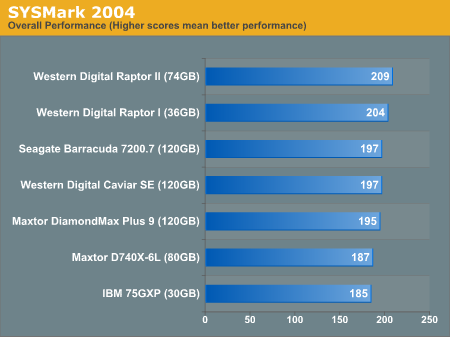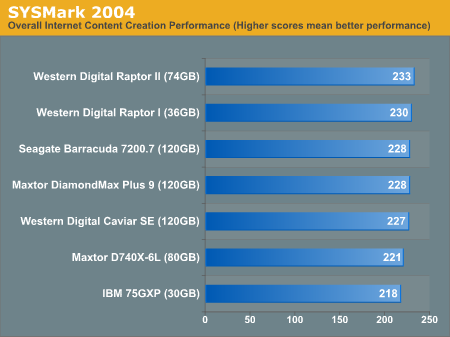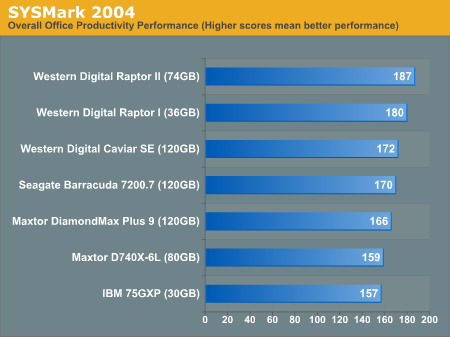Q2 2004 Desktop Hard Drive Comparison: WD Raptor vs the World
by Anand Lal Shimpi on June 7, 2004 12:05 AM EST- Posted in
- Storage
SYSMark Performance Summary
The overall SYSMark scores summarize what we've seen thus far:

As a recap, here's what happens with the Internet Content Creation suite:
"In this scenario, the content creator creates a product-related website targeting a broadband and narrowband audience. The user first renders a 3D model to a bitmap, while preparing web pages using a web site publishing tool. The user opens a video editing package, creates a movie from several raw input movie cuts and sound cuts and starts exporting it. While waiting on this operation, the user imports the rendered image into an image-processing package, modifies it and saves the results. Back in the 3D modeling software, the user modifies a 3D model and exports it to a vector-graphics format. Once the movie is assembled, the user edits it and creates special effects using one of the modified images as input. The user extracts content from an archive. Meanwhile, he uses an animation creation tool to open the exported 3D vector graphics file. He modifies it by including other pictures and optimizes it for faster animation. The final movie with the special effects is then compressed in a format that can be broadcast over broadband Internet. The web site is given the final touches and the system is scanned for viruses."

In the Internet Content Creation tests, we see that although there is a difference in performance between current and previous generation hard drives, there's very little that separates the 10,000RPM Raptors from the 7200RPM drives.
Also recapping, here's what happens in the entire Office Productivity suite:
"In this scenario, the office productivity user creates a marketing presentation and supporting documents for a new product. The user receives email containing a collection of documents in a compressed file. The user reviews his email and updates his calendar while a virus checking software scans the system. The corporate web site is viewed and the user begins creating the collateral documents. The user also accesses a database and runs some queries. A collection of documents are compressed. The queries' results are imported into a spreadsheet and used to generate graphical charts. The user then transcribes a document. Once the document has all the necessary pieces in place, the user changes it into a portable format for easy and secure distribution. The user edits and adds elements to a slide show template. Finally, the user looks at the results of his work (both the slide show and the portable document) in an Internet browser. "

Office Productivity paints a much different picture, with significant advantages being seen over older drives. The Office Productivity suite also paints a much more compelling picture of the Raptors' performance; even the older Raptor manages to maintain a decent performance advantage over the cream of the crop 7200RPM 8MB Parallel ATA drives.
Overall performance is an average of the two suites, and thus, we see that a lot of the impressive performance gains in Office Productivity are diluted by the relatively little variation in Internet Content Creation performance.










50 Comments
View All Comments
SignalPST - Monday, June 7, 2004 - link
Great review, I must say. But one thing that would certainly interest alot of people including myself would be using RAID. We know that using multiple hard drives in a RAID array is very popular among gamers and almost every motherboard out now supports RAID as well. I'm sure it'll be quite interesting to see 4 of 74GB Raptors in RAID 0 in future reviews! It would also be interesting to see the different effects of stripe sizes configurations.Doormat - Monday, June 7, 2004 - link
What about putting some meta-data in there? Like current street price, length of warranty, etc. Also temperature would be nice.I'd kinda like to see some RAID tests too, I'm looking at RAID 5 for a bunch big drives for a video on demand system.
Speaking of, a big-drive comparison would be cool too. Where's that hitachi 400GB drive they announced a while ago?
Murst - Monday, June 7, 2004 - link
Hmm,well, I'm pretty sure that there should be a significant difference in system performance when your system runs out of RAM. When virtual memory takes over, I have seen the performance of my computer drop significantly. I was hoping that a benchmark could be made showing just how large of a difference could be seen when virtual memory is a significant source of data for program execution. There should be a noticable difference in this performance between different drives.
Also, it would be interesting to know if the file system on a drive makes a difference in performance. I have a feeling that if it does, it would be unnoticable, but nevertheless, unless its tested, we would never know for sure. I don't neccessairly mean the type of file system, either. Just as RAM can have different latency settings, so can a hard drive have different block sizes (and optimal block sizes).
Again, I'm not positive if this would make a difference in performance, but I'm just trying to think of practical tests for hard drive performance.
Anand Lal Shimpi - Monday, June 7, 2004 - link
Murst,Sorry, the last response must've been posted at the same time as yours :)
Both the Winstone and SYSMark tests use multiple applications running at the same time, but I do understand the point you're trying to make.
We do have a synthetic test that shows the benefit of defragging a hard drive, but I have yet to do significant investigation in to how that affects performance between drives other than it reduces it.
Take care,
Anand
Anand Lal Shimpi - Monday, June 7, 2004 - link
Must,The drives being tested are secondary drives only for the game loading tests and the theoretical IPEAK tests. The remaining Winstone and SYSMark tests all use the drive as the only drive in the system.
Take care,
Anand
Murst - Monday, June 7, 2004 - link
Hmm... let me clarify that. I believe that all of your tests were probably ran with no other programs executing. It would be interesting to see the difference in performance when a lot of page swapping is occurring (ie, fill up the page table by executing other programs and then run a benchmark).Oh, and I just thought of another issue... why not have a benchmark which evaluates a drop in performance of a drive with data that is, say, 60% fragmented as compared to mostly unfragmented data.
Murst - Monday, June 7, 2004 - link
Its nice to see a hard drive comparison. I will be building a new comp soon and I always wondered if I'd see a difference between drives.I do, however, have one concern. It seems like the drives you used were secondary drives in the system, with the operating system working off a different drive. I have always assumed that the largest benefit of choosing a very fast drive was to minimize the access and read times of a page fault (as I generally do not spend much time at all waiting for something to load). It would seem that none of your tests take this into consideration.
Thanks
Anand Lal Shimpi - Monday, June 7, 2004 - link
#1 - You're correct, the mentions of command queuing were leftover from some early tests on a new SATA controller with support for the feature. Those tests didn't make it into the article, and I've updated it accordingly.Take care,
Anand
jliechty - Monday, June 7, 2004 - link
#1 - I was under that assumption also. I do recall hearing of a controller chip that supported TCQ being in the works (or perhaps already available), but the question remains whether that chip has been put in any controllers that are on the market at this time?Anyway, I'm glad that my preciousss... er... my Raptor didn't do too badly, though for what I do I probably could have kept my old WD Caviar Special Edition and not noticed much of a difference, except for my wallet being heavier. :-(
RyanVM - Monday, June 7, 2004 - link
Doesn't the WD74GD require a controller which supports command queuing in order for that feature to be of actual use? And I was under the impression that no current SATA controllers support that function.